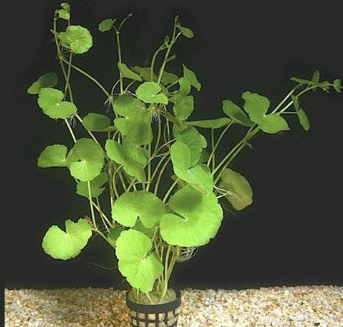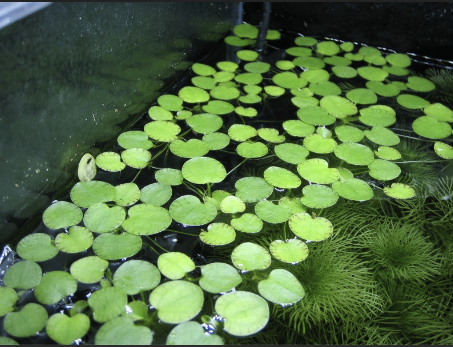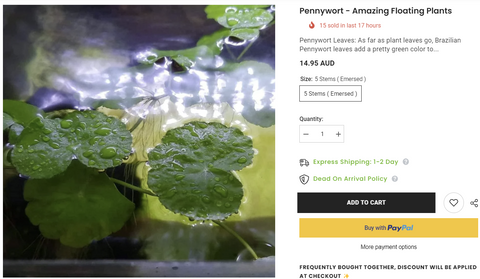Vibrant, rich and fresh, Pennywort is a great addition to your aquarium, big or small. They go by many names, like Brazil Water Ivy or often simply Pennywort.
Pennywort is easy to grow, easy to care for, and versatile in application, which makes it a great start plant for those just beginning in freshwater aquariums.
In this article, we'll take a look at everything you need to know about this amazing aquatic plant, as well as how you should care for and decorate your aquarium.
Pennywort plant facts.
When you buy pennywort, choose plants that are light green, with perfect leaves - without holes, tears, cracks, or darkening.
The trunk is very flexible, vines, and durable, so you have to make sure the trunk is not yellowed, soft and not broken.
The roots of pennywort are almost white in colour and have a smooth texture when they appear below the stem joints.
The roots often look like bean sprouts if they are planted on the substrate.
How to take care of pennywort.
As I mentioned earlier, one of the best aspects of keeping Pennyworts in your tank is how easy they are to care for.
As a root plant, pennywort is best grown in the base or mid-tier, although some players also prefer to plant them near the front of the tank.
Floating pennywort will also provide shelter to your tank inhabitants who want a place to hide or breed. Regardless of whether it is rooted or floating, the growth rate of a plant can be quite rapid under the right conditions.
In fact, it can quickly take over your tank, so make sure to plan your aquarium carefully, most beginner aquariums have pennywort.
Roots & Stems.
Despite their strength, Brazilian pennywort can easily break if bent or pulled hard. Most of the trunk will be damaged by pruning.
The trunk can also be damaged if you are not careful when moving decorations or the tree itself. Furthermore, pennywort can grow towards the intake of the power filter, which can lead to damage to the stem when you try to untangle the mess afterwards.
However, there is good news:
If the stem of your Brazilian pennywort is broken, there is a high chance that the broken part will be able to survive and grow back on its own.
Water condition.
Caring for your Brazilian pennywort is easy thanks to the plant's adaptability and its ability to survive in different water conditions. Here are the basic conditions your pennywort needs to survive:
✅Water temperature: 20℃ – 28℃
✅Water pH: 6.0 – 7.0
✅Tank Size: Any size will do, although plants can grow and dominate quickly.
Pennywort can also help you maintain water quality by keeping nitrate levels low, and it is one of the most useful active plants for this reason.
If you don't take care of your tank's maintenance, you shouldn't expect your Pennywort to magically perform its filtration.
How to grow pennywort.
Whether you have a complex aquarium or you are working with a low-tech, low-light tank, pennywort has a fairly fast growth rate.
The more light there is during the day or the stronger your light, the more your pennywort can spike.
On the other hand, some liquid plant fertilizers can kill plants, so you should research the effects of a specific fertilizer before adding it to your tank.
Trimming your pennywort:
✅Find the part of the tree that needs pruning
✅Carefully cut it with pruning shears
✅Do not pull or pull the trunk
✅Try not to tear the tree
Before long, the plan will begin the process of growth. You can even make an entire Pennywort plant from a single healthy leaf, as long as it has some attached stems. Then just let the leaf float freely in the water.
Pennywort for sale.
Pennywort common disease:
No growth.
If your pennywort isn't growing, it means it's not getting the nutrients it needs. Check that the CO2, light, and nutrients in your tank are balanced and make any necessary adjustments.
Sparse growth.
If you notice that the plant is growing but seems very sparse, you may have a problem with the light. Any pennywort will lose at least some of its bottom leaves when it comes to the surface because of the simple fact that they don't get enough light.
Yellow leaves appear on pennywort.
One thing that many people don't know about pennywort is that it is prone to iron deficiency. So, if you notice your pennywort leaves turning yellow, dying and falling off, the cause is usually an iron deficiency.
To mitigate this, add some iron to your plant's 'diet' and you'll notice it's working again in no time.
The location of the pennywort tank.
As a floating aquatic plant, pennywort is a specimen with a special function as it can grow as a floating plant or in a substrate, as we already mentioned.
When you have a Pennywort, it will provide an ideal hiding place for the fry in your tank, as well as a great environment for infrasound to thrive.
It's not uncommon for parts of your pennywort to rise to the surface and sprout small white flowers. These can add beauty to your aquarium.
No matter how you choose to grow it, your pennywort will progress to the top of the tank, with the lower leaves dying off the taller the plant.
The advantages of growing pennywort.
Pennywort has the ability to reduce nitrate levels in your tank very well. Unfortunately, filters cannot remove nitrate from the aquarium, and when the water has a high enough nitrate content, it can be toxic to fish.
Pennywort uses nitrate as a fertilizer, making it the perfect nitrate neutralizer. Plants also have the ability to regulate water, which is very beneficial for your fish.
Aquarium lights are more than enough to let your Pennywort grow, so you don't have to leave your tank in direct sunlight. When there is any light, pennywort absorbs Co2 and releases oxygen throughout the water.
Fish love the natural environment and pennywort gives the perfect natural look and feel to help your fish reproduce. You may see females laying eggs on leaves or hiding them in their roots.
Furthermore, adult fish have a nasty habit of eating their young, but your young fish can hide among the pennywort leaves and avoid them. The fry also loves to snack on plants and pennywort produces enough leaves for them to enjoy a delicious meal.
Final thought.
Brazilian pennywort is a great addition to any aquarium you have, large or small. Hope this article gives you information about these amazing floating aquarium plants.
You can view them for free here, or if you're free tomorrow, visit our store at:
Micro Aquatic Shop - The Aquarium Shop Near Me.
Unit 15, 2-8 Daniel Street, Wetherill Park, NSW 2164
Customer support: (02) 8320 3037
Email: support@microaquaticshop.com.au














